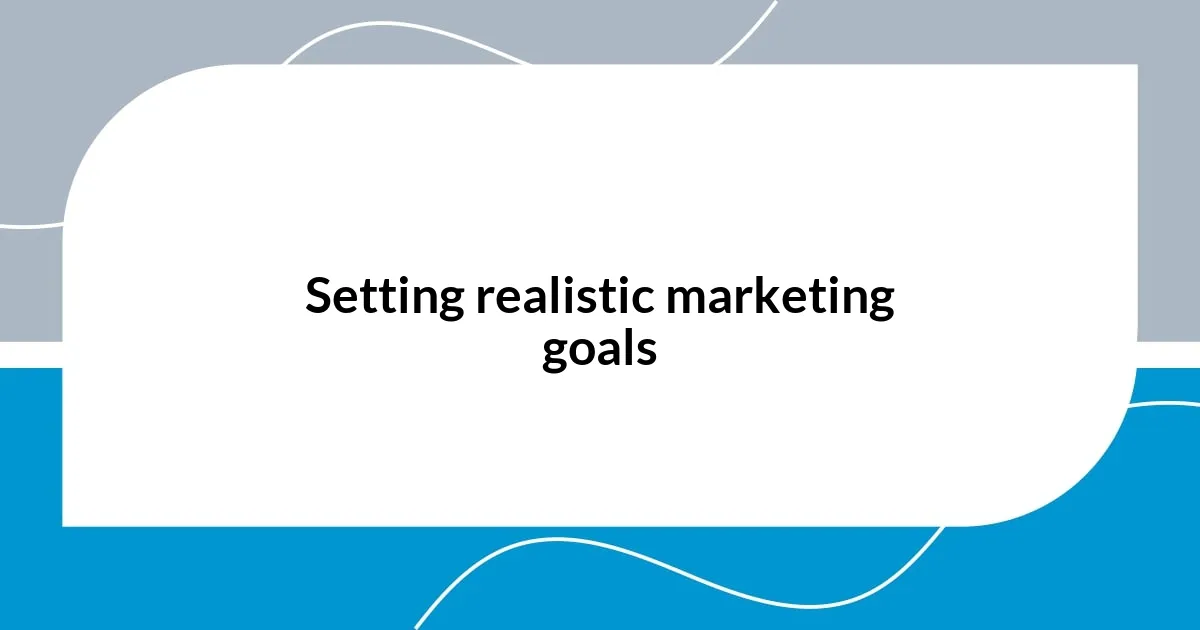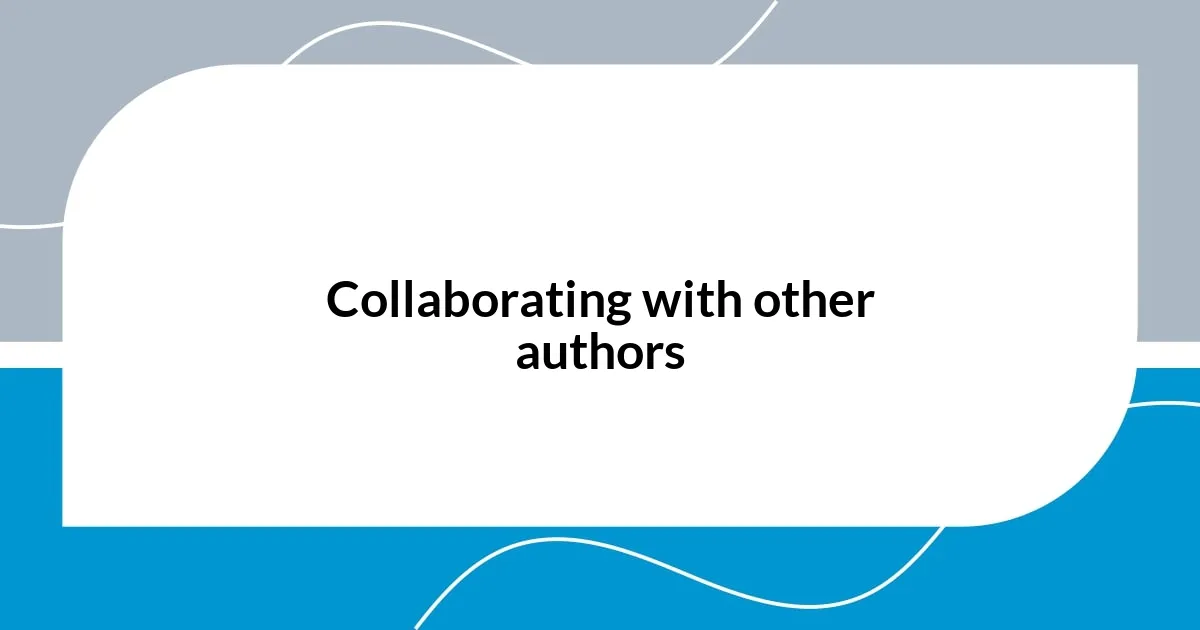Key takeaways:
- Understanding the target audience is essential for effective marketing; engaging with readers on social media helps create reader personas that guide promotion strategies.
- Setting realistic marketing goals, such as focusing on community engagement rather than sales figures, leads to more rewarding experiences and sustainable growth.
- Building an author platform through a professional website, social media engagement, and local events fosters genuine connections with readers and fellow authors.
- Collaborating with other authors can enhance visibility, expand audiences, and provide valuable learning experiences through shared resources and joint promotions.

Understanding the target audience
Understanding your target audience is crucial in the marketing of any novel. When I was crafting my first book, I took a moment to reflect: Who would genuinely connect with my story? This reflection led me to connect with readers on social media platforms where discussions about similar genres flourished, illuminating insights into the preferences and interests of my potential audience.
One memorable moment was during a late-night online chat in a writers’ group. A fellow author shared her experiences about understanding her readers’ needs and desires – it inspired me to create reader personas based on age, interests, and reading habits. Isn’t it fascinating how your audience can actually shape your writing? By engaging in these conversations, I began to see my readers as real people rather than mere numbers, and that realization transformed my approach to marketing my book.
Ultimately, I realized that knowing your target audience is like having a secret map that guides your promotional efforts. I often asked myself what issues or themes resonated with them emotionally. Discovering that passion not only helped me tailor my marketing strategies but also made me feel connected to my readers, which fueled my excitement to share my work with them.

Setting realistic marketing goals
Setting realistic marketing goals plays a pivotal role in successfully launching your novel. I remember when I first set out to promote my book; I felt overwhelmed by the possibilities. Initially, I aimed to achieve a bestseller status within the first month. However, as I dug deeper, I realized that aiming for a slower, steady growth made more sense. Instead of lofty sales targets, I shifted my focus to building a solid reader community and gradually increasing my engagement on various platforms. This perspective allowed me to celebrate smaller milestones, which made the journey feel more rewarding.
In my experience, it’s essential to differentiate between the types of goals you set. For instance, I found that having an encouraging social media following to interact with was more gratifying than merely watching sales figures. Setting goals like “gain 100 followers this month” or “connect with at least three book bloggers” allowed me to gauge my efforts’ effectiveness while establishing meaningful connections. Moreover, these smaller achievements acted as stepping stones, helping me build momentum throughout my marketing journey, ensuring I remained focused and motivated.
Another important aspect is to review and adjust your goals regularly. I learned this the hard way after setting a fixed target for newsletter sign-ups. I wasn’t accounting for the fluctuations in my engagement levels throughout the year. After a few months of static growth, I decided to evaluate my approach, try different incentives for readers, and explore collaborations with other authors. This not only reignited my enthusiasm but also transformed my strategy into a more dynamic and responsive plan.
| Type of Goal | Description |
|---|---|
| Sales Goals | Aim for specific sales numbers over time, but adjust as needed. |
| Engagement Goals | Set targets for social media followers or reader interactions. |
| Community Building Goals | Focus on fostering connections with authors and readers through emails and collaborations. |

Building an author platform
Building an author platform is like laying the foundation for your literary career. My journey began with simple choices—starting a blog and sharing my thoughts about writing and reading. I quickly realized that the more I shared my authentic self, the more connections I made with readers and fellow authors alike. One evening, after posting about my writing struggles, I got a heartfelt message from a reader who had faced similar challenges. That moment reinforced my belief that vulnerability builds bridges, and in turn, strengthens your platform.
To effectively build your author platform, consider the following steps:
- Create a Professional Website: This serves as your digital home and portfolio, showcasing your work and updates.
- Engage on Social Media: Platforms like Twitter, Instagram, and Facebook can help you connect with readers and other writers. I found immense value in joining Twitter discussions around my genre; it opened doors to meaningful conversations.
- Start a Newsletter: Keep your readers informed about your writing process, new releases, and exclusive content. I launched mine after realizing how much readers appreciated behind-the-scenes peeks into my creative journey.
- Attend Events: Whether online or in-person, literary events and conventions can expand your network and expose you to potential readers. I still remember the thrill of connecting with other authors at my first local book fair.
- Collaborate with Other Authors: Team up for joint promotions or guest blog posts; it can introduce your work to a broader audience. A co-hosted event I organized with another novelist resulted in a significant increase in both of our email subscribers.
These steps formed the backbone of my author platform, turning my solitary writing endeavor into a vibrant community of readers and fellow authors. Building a platform isn’t merely about self-promotion; it’s an ongoing conversation with the very people who inspire your writing.

Utilizing social media effectively
Utilizing social media effectively requires a deliberate and authentic approach. I still remember when I first started on platforms like Twitter and Instagram. I was unsure about how to engage without sounding too promotional. However, I learned that sharing snippets of my writing process not only drew in readers but also invited them into my journey. Have you ever considered what it’s like to have readers cheering for you? That feeling is incredibly motivating.
Engagement is key. I found that asking questions in my posts sparked conversations. For example, I once shared a poll asking readers about their favorite character tropes. The responses were not only fun to read but also gave me insights into my audience’s preferences. By embracing this interactive component, I transformed my social media presence from just a broadcast platform to a genuine dialogue with my readers. It’s like building a community where everyone feels valued.
Consistency is important too. I learned the hard way that sporadic posts didn’t help maintain momentum. Establishing a content calendar made a world of difference. I started planning themed weeks, sharing writing tips on Mondays and character backstories on Thursdays. This rhythm created anticipation among my audience, which I found incredibly rewarding. Have you thought about how a structured approach might benefit your outreach? It turned my irregular presence into something that felt like a routine, keeping both me and my readers engaged.

Engaging in local events
Engaging in local events opened up a world of opportunities for me. I vividly remember my first book signing at a quaint local bookstore. As I set up my table with books and bookmarks, I felt a mix of excitement and nerves. When a mother and her daughter approached, eager to find something new to read, it was the perfect moment to share my novel’s story. There’s something magical about discussing your work face-to-face, isn’t there? It creates a connection that transcends the written page.
Participating in community events also allowed me to network with fellow authors and artists. I’ll never forget a writer’s workshop I attended—it was inspiring to hear others share their journeys and struggles. Those conversations not only fueled my passion but helped me to realize that we’re all navigating the same chaotic waters of creativity. Does it surprise you how communal a solitary act like writing can become when shared with others? Collaborating with local authors afterward led to a joint reading event, which doubled our audience and fostered a spirit of camaraderie.
Additionally, volunteering at local literary festivals brought a deeper appreciation for the book community. I helped organize panels and served as a moderator, which provided a unique perspective on event management. The thrill of facilitating discussions among authors and engaging with enthusiastic readers was exhilarating. Have you ever caught yourself completely immersed in conversations about books? Those moments remind me that we, as writers, are part of a larger narrative. Engaging locally not only promotes my work but enriches the community that has supported my journey.

Collaborating with other authors
Collaborating with other authors was a game-changer for me. I remember when I reached out to a fellow debut novelist whom I met online. We decided to host a dual book launch event, which not only boosted our visibility but also created a vibrant atmosphere filled with energy and excitement. Have you ever thought about how powerful it is to amplify your efforts by teaming up with someone who shares your passions? That synergy can draw in different audiences, making it a win-win for both parties.
I’ve found that author collaborations can take many forms beyond events. For instance, I joined a group of writers who were eager to share our resources, from marketing strategies to co-promotions on social media. In one instance, we all featured each other’s work on our blogs over a week, creating a steady stream of new readers for each of us. How often do you get the chance to tap into another author’s audience? It’s a brilliant way to expand your reach while supporting fellow creatives.
Moreover, I participated in anthologies with other writers, which was a fantastic experience. Contributing a short story alongside established and emerging authors not only honed my craft but also exposed me to diverse styles and perspectives. It’s fascinating to see how different voices can come together around a shared theme, isn’t it? Each collaboration has taught me something new about storytelling and marketing, and I genuinely believe that sharing our journeys enhances the entire writing community.

Tracking results and making adjustments
Tracking the results of my marketing efforts for my first novel was akin to peering into a mirror—it revealed both strengths and weaknesses. I remember diligently analyzing social media metrics after each campaign; watching engagement levels rise and fall provided insights that were both enlightening and humbling. Have you ever found that a simple number can tell an entire story? For me, each like, share, or comment had a narrative that shaped my next steps.
As I sifted through feedback and reviews, I learned where I needed to pivot. I distinctly recall a time when my initial strategy focused heavily on Instagram, but I realized my readers were more active on Facebook. Adjusting my efforts felt daunting at first, yet embracing that change allowed me to connect with a broader audience. It’s fascinating how our audiences can lead us in unexpected directions, isn’t it?
Beyond social media, I kept a close eye on book sales and event attendance. After hosting a few local readings, I noted that those who actually attended were more likely to buy my book afterward. I decided to double down on live events, refining my approach to make each one more engaging and memorable. It’s all about collecting data, making adjustments, and never being afraid to change your course. Wouldn’t you agree that adaptability is vital in this unpredictable journey of creativity?